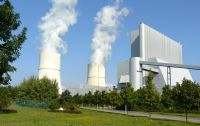Carbon Capture Effort Collects Critics
Source: ipsnews.net
The capture and underground storage of greenhouse gases, especially carbon dioxide, is a dubious method of effectively reducing the pollution that causes global warming, experts warn.Scientists, environmentalists and local communities continue to object to the method, which consists of compressing and liquefying carbon dioxide before sending it to underground deposits, and which has been applied for some time to recover petroleum and gas from partially exhausted oil wells.
 Left: Schwarze Pumpe, a pilot thermal power plant south of Berlin that uses technology to capture and store carbon emissions.
Left: Schwarze Pumpe, a pilot thermal power plant south of Berlin that uses technology to capture and store carbon emissions. Credit:Vattenfall
The Intergovernmental Panel on Climate Change (IPCC) looked at these techniques in 2007, and more closely in 2005, when its Working Group III published a 443-page report.
Germany's federal government was forced last summer to halt the process for approving a law authorising the capture and deposit of carbon, after facing opposition from local communities in the regions preliminarily selected for experimenting with the technique.
Rejection of the process has been fuelled by scientific reports and environmental groups. In 2006, geologist Gabriela von Goerne, of the German branch of Greenpeace, said such methods should only be used as a last option in the fight against global warming.
"The main objective to mitigate climate change should be cutting carbon dioxide emissions at point of origin," von Goerne told Tierramérica. That means a continued reduction in the use of fossil fuels - the main source of carbon dioxide - in human activities.
"By reducing fossil fuel consumption, the demand naturally shifts toward energy sources that don't produce carbon dioxide, like solar, wind and hydro energy," she said.
Instead, the massive capture and storage of carbon would create a stimulus to continue using fossil fuels, and would be an obstacle to the expansion of clean and renewable energy sources.
"Furthermore, it's expensive and consumes a lot of energy, which reduces its efficiency," von Goerne added.
The costs of capturing and storing carbon vary. At electrical plants run on coal or other fossil fuels, capturing and compressing CO2 is relatively simple.
But because the sites planned for storing the carbon are rarely located near the power plants that produce it, it is often necessary to build a pipeline network to carry the liquefied gas from the source to the storage location.
"Just imagining such a pipeline network across Germany is absurd," commented von Goerne.
CO2 can also be extracted from the fuels before combustion, or combustion should take place in an environment into which pure oxygen is injected so that it generates only CO2 and water. In both processes, CO2 has to be compressed and liquefied for transport.
In all cases, capturing the gas itself requires a great deal of energy, reducing the efficiency of the overall process. In 2005, the IPCC estimated that capture and compression of CO2 would increase consumption of fuel at a coal-fired power plant by 25 to 40 percent.
A third argument against this technique is geological: nearly all experts, including operators of test storage sites, agree that storing CO2 can involve gas leaks and cause underground movement, with unpredictable environmental consequences.
A colloquium on carbon capture and storage held in Paris in February, involving French and British experts, included among the difficulties the environmental risks and related problems of acceptance.
It's possible that CO2 leaks at storage sites "could pollute ecosystems and affect human health," Sophie Galharret, of France's Institute of Sustainable Development and International Relations (IDDRI), told Tierramérica.
"Currently it is very difficult to conceive of a way to manage such risks in the public debate to support a widespread application of carbon capture and storage," said Galharret, who participated in the discussions.
The fact that the German government has not approved the law to allow it is just one example of the difficulties the process faces.
Norway, the world's second leading producer of natural gas, supplies 17 percent of European demand and since 1996 has had an experimental CO2 capture and storage system, with storage sites in the North Sea.
According to Brian Bjordal, director of the state-run company Gassco, which coordinates gas distribution from Norway's fields to the rest of Europe, Norway could be compared to a trapeze artist, and the rest of the continent would be the circus audience.
"At the circus, the audience incites the trapeze artist to jump. But if they were in his place, nobody in the audience would jump," Bjordal told Tierramérica, illustrating his own uncertainty about the capture and storage method.
According to IDDRI's Galharret, there is another argument against it: the possibility of failure. And that is linked to a key factor - the pressure of the timeline to reduce greenhouse emissions.
"If the commercial use of carbon capture and storage fails for technical or economic reasons, we won't know until 2015 to 2020. If it fails, Europe would have very little time to readapt its emissions reduction strategies," she said.
Article from: IPSNews.com






















